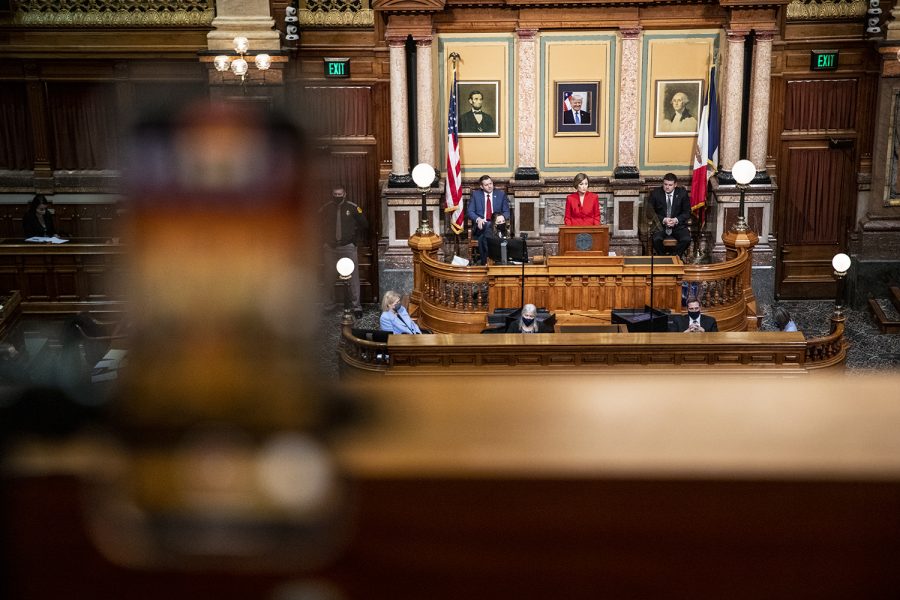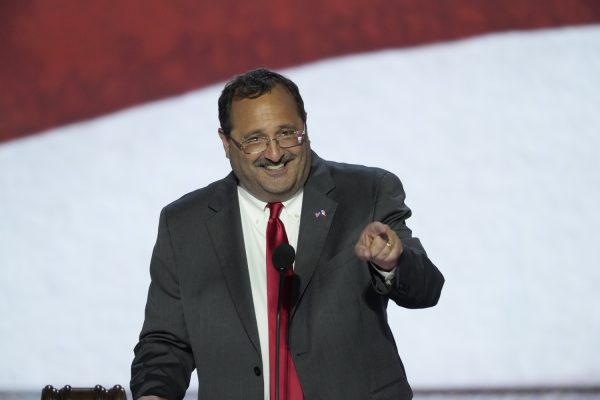Fact Check | The facts behind Gov. Reynolds’ Condition of the State Address
The Daily Iowan/PolitiFact Iowa fact checked Iowa Gov. Kim Reynolds’ Condition of the State Address.
January 12, 2021
PolitiFact Iowa is a project of The Daily Iowan’s Ethics & Politics Initiative and PolitiFact to help you find the truth in politics.
If your time is short:
- Iowa entered 2021 amid the COVID-19 pandemic with a budget surplus, although the state cut budgets to make it happen.
- Gov. Kim Reynolds pushed for legislation that will give parents more opportunity to send their children to in-person school during the pandemic but also to have options for open enrollment.
- Reynolds used facts in her annual Condition of the State address but more exist with some of the topics.
Iowa Gov. Kim Reynolds took the podium in the House of Representatives chamber at the Iowa Statehouse Tuesday night, Jan. 12, and summed up 2020.
“It’s been a year,” she told the joint House-Senate session to kick off her annual Condition of the State address. “And I’ll let you fill in whatever adjective you want. COVID-19. Civil Unrest. A drought. A derecho. We’ve been beaten and battered in about every way imaginable and some unimaginable. But together, we’ve met every challenge with bravery and outright grit.”
The rosy assessment served as a launch pad for a collection of anecdotes about inspiring Iowans and a series of claims and proposals for the year ahead. A Daily Iowan and PolitiFact Iowa analysis found facts to back up what Reynolds cited but a few necessary explanations to fully understand what she said.
Here are a few of those explanations.
“When I stood here last year, our fiscal health was strong. We had one of the lowest unemployment rates in the country, incomes were going up, and our economy was roaring. Then 2020 happened.”
PolitiFact Iowa has checked Iowa’s pre-pandemic financial standing before. That includes the unemployment rate bottoming out at 1.8 percent in 2018 and wages going up. But 63 percent of Iowa workers earned less than the state’s median salary of $47,350 in May 2019.
Iowa’s workforce reached a historic high of 1,704,900 people in January 2020.
“Because of conservative budgeting practices, Iowa’s diverse economy, the decision to keep over 80 percent of our businesses open, and because of the tenacity of our people, Iowa isn’t facing a massive budget shortfall like many states. As I stand here tonight, our unemployment rate has returned to 3.6 percent, one of the lowest in the country, and our GDP grew over 36 percent in the third quarter of 2020, outpacing the nation.”
It’s mostly true that the state’s economy has been more resilient in the face of COVID-19 than economies in other states. Iowa has not lost large chunks of revenue like states that rely heavily on tourism or oil — industries which took a big hit during the pandemic.
According to a July 2020 report by the Council of State Governments, Iowa ranked as the state with the lowest projected losses from the pandemic — expecting to lose just 4 percent of its revenue because of COVID-19. But, the researchers attribute that to the state’s makeup of industries, financial and agricultural, being insulated from social distancing shutdowns rather than relaxed business restrictions. An analysis of Bureau of Labor Statistics data by The New York Times showed that by September, Iowa had gained back just about one-half of the 186,000 jobs lost from February to April.
And yes, Iowa’s GDP grew 36.4 percent in the third quarter of 2020 — outpacing the nation’s 33.4 percent growth — according to a December 2020 report from the Bureau of Economic Analysis. While the state outpaced the national growth rate, it fell near the median when compared to rates of growth of all 50 states and the District of Columbia. The growth rates ranged from the District of Columbia, at 19.2, to Nevada’s 52.2 percent.
In December 2020, Iowa’s unemployment rate reached 3.6 percent, according to the Iowa Workforce Development monthly reports, and ranked No. 4 in the country in November for lowest state unemployment rate.
The COVID-19 pandemic strained state spending, though, because state revenue was coming in at a lower than expected pace. That led to cuts in what originally had been approved for state spending in fiscal 2021, Reynolds’ office announced in June. The moves came after Iowa’s Revenue Estimating Conference projected the state anticipating $360.1 million less in tax collections for fiscal 2020, which ended June 30.
State agencies, like the state universities, sustained deep financial losses because of the pandemic. The University of Iowa, for example, was losing some $70 million in anticipated revenue because of the pandemic, university officials said.
When the numbers finally were counted, the state ended fiscal year with a $305.5 million surplus in its general fund, up from $289 million the previous year, the governor’s office announced in September.
The governor’s proposed budget for fiscal 2021 calls for $7,783,550,294 in state appropriations, up less than 1 percent from $7,832,949,601 in fiscal 2020.
“About a third of our counties are still broadband deserts, where high-speed internet is rarely offered. And for many Iowans, it’s just not affordable. Iowa also has the second lowest broadband speeds in the country.”
Finding a good map or database that shows where broadband deserts exist is not easy, the NTCA-the Rural Broadband Association press office says. Various reports show different numbers but a Federal Communications Commission report showed that 93 percent of Iowans had access to internet speeds capable of handling HD streaming, music downloads and internet searchers.
That average is 25 megabits per second (Mbps) to download and 3 Mbps to upload, the FCC reported. A little more than 93 percent of Iowans had access to those speeds but where they live mattered. The report said 84 percent of rural Iowans had the access, while 98 percent of urban dwellers had it. But much higher speeds exist, up to 1 gigabits per second (Gbps), that allow for more powerful internet experiences.
The average internet speed in Iowa is 29 Mbps, the research firm Broadband Search reports. Its numbers vary from the FCC report’s numbers but are close.
“The vast majority of our schools found a way to safely and responsibly reopen, all day, Monday through Friday.”
According to a summary of weekly COVID-19 data collection from the Iowa Department of Education, between Dec. 7 and Dec. 13, 79 percent of school districts and non-public institutions were fully in person, 19 percent were hybrid and 2 percent were all online. In that same week 0.3 percent of Iowa students reportedly tested positive for COVID-19 and 3.1 percent were quarantining. However, participation in this survey is optional for districts and non-public institutions, so it does not capture the statistics for all schools across the state.
Additionally, of the 327 school districts in the state, 67 have requested this school year that one, several, or all of the schools in their district move to remote learning for two weeks. Several districts sent in multiple requests.
Since July 2020, Iowa’s Department of Education has received more than 120 total requests, only six of which the state has denied. In support documents submitted with these requests, the districts have cited community COVID-19 positivity rates, student positivity rates, absenteeism, and the amount of students quarantined as reasons they requested a waiver to move classes online.
“Iowa has more households with all parents working than any other state, yet we’ve lost one-third of our childcare spots over the last five years.”
According to a report from Iowa Child Care Resource and Referral comparing data from 2015 to 2020, the state’s total number of childcare programs has decreased by 33 percent in the last five years. In 2015, there were 7,560 programs. In 2020, that number had been reduced to 5,101. Additionally, the number of children with all parents in the workforce increased by 1 percent in those five years.
According to the Iowa Department of Human Services, in March 2020 the state lost 49,750 childcare slots as a result of homes and providers closing due to COVID-19.
The United States Census Bureau’s 2015-2019 ACS 5-Year Data Profile showed that nationally, 66.2 percent of households with children under six years old had all parents in the workforce, while 71.5 percent of households with children from six to 17 years old had all parents in the workforce.
In Iowa those numbers were 75.1 percent and 80.5 percent respectively, while Minnesota’s were 76 percent and 80.2 percent, Wisconsin’s were 73.8 percent and 78.7 percent, Illinois’ were 69.4 percent and 73.5 percent, Missouri’s were 69.9 percent and 75 percent, Nebraska’s were 73.7 percent and 79.3 percent, and South Dakota’s were 73.8 percent and 80.3 percent.
“We should never be afraid to talk about ways to improve policing, but there will be no talk of defunding the police.”
PolitiFact visited this high-powered phrase in a June 9, 2020, story that stated: “While some protesters want to eliminate police departments entirely, others want to revisit the functions of police departments and reroute some of their funding toward other services.”
Disbanding a police department is rare, Maria (Maki) Haberfeld, a professor at John Jay College of Criminal Justice in New York City, told PolitiFact for that story. The few police departments that have disbanded in recent decades did so in regional reorganizations and to save money, PolitiFact reported.
Two Black Lives Matter protesters in Des Moines, the site of several summer protests along with other Iowa cities, told The Des Moines Register that they don’t want to get rid of police altogether. Rather, Matthew Bruce and Indira Sheumaker told the newspaper, they want money diverted from police functions viewed as oppressive to Black people and others to programming that builds stronger communities.
“To date, nearly 100,000 Iowans, including our healthcare workers, have received their first (COVID-19 vaccine) dose, and several thousand have now received their second.”
The Iowa Department of Public Health published data on Jan. 11 showing that total COVID-19 vaccinations administered in Iowa had reached 96,686, with 91,501 of them administered to Iowa residents. The same report shows that 85,382 vaccines have been initiated, meaning the first dose was administered, and that 5,652 vaccinations have been completed with both doses.
“And I’m proud to say that Iowa is one of the states leading the nation in administering the vaccine.”
This is mostly accurate. The federal Centers for Disease Control and Prevention updated vaccination data on Jan. 12 showing that Iowa had administered, to date, 3,128 vaccines per 100,000 people, putting the state 17th among all 50 states in terms of vaccine administration.
Iowa drops to 20th place if U.S. territories and federal entities are included, where Washington, D.C, Northern Mariana Islands, and American Samoa all have higher rates of vaccine administration.
Reynold’s Communication’s Director Pat Garrett said Iowa has administered about half of the vaccines the state was allocated, making Iowa’s vaccination rate in that sense the ninth highest in the country.
Sources
The Daily Iowan and PolitiFact Iowa, “Iowa had a strong job market and low unemployment before coronavirus,” by Caleb McCullough, April 15, 2020.
The Daily Iowan and PolitiFactIowa,”Pre-pandemic Iowa had largest workforce in state history,” Sarah Watson, Jan. 11, 2021.
The Council of State Governments report, “COVID-19: Fiscal Impact to States and Strategies for Recovery,” July 2020.
New York Times, “Iowa Never Locked Down. Its Economy Is Struggling Anyway.” by Ben Casselman and Jim Tankersley, Oct. 22, 2020, updated Nov. 3, 2020.
Bureau of Economic Analysis, “Gross Domestic Product by State, 3rd Quarter 2020,” Dec. 23 2020.
Memorandum to legislative leaders, by David Roederer, Department of Management director, June 12, 2020.
The Daily Iowan, “UI outlines further budget cuts, president’s salary proposed to be cut in half,” by Caleb McCullough, July 10, 2020.
Press release from Gov. Kim Reynolds’ office, Sept. 30, 2020.
Iowa Budget Report, FY 22-23.
Iowa Workforce Development press release, “Iowa’s Unemployment Rate Drops Slightly to 3.6 Percent in November,” Dec. 18, 2020.
U.S. Bureau of Labor Statistics, “Unemployment Rates for States.”
Federal Communications Commission, “2020 Broadband Deployment Report” and “Appendix 1: April 24, 2020.
Phone call with Lauren Gaydos, NTCA-the Rural Broadband Association press office.
Broadband Search, “Internet Service in Iowa.”
Allconnect.com, “Internet speed classifications: What’s fast, what’s slow and what is a good internet speed?” Aug. 6, 2020.
Iowa Department of Public Health, “Iowa COVID-19 Vaccine Doses Administered Report,” Jan. 11, 2021.
Centers for Disease Control, “CDC COVID Data Tracker”
PolitiFact, “‘Defund the police’ movement: What do activists mean by that?”, by Miriam Valverde, June 9, 2020.
The Des Moines Register, “Des Moines officials balk at activists’ calls to defund police, an idea some see as part of ‘abolition movement‘,” by Shelby Fleig and Andrea May Sahouri, July 20, 2020, updated July 23, 2020.
Iowa Department of Education, “Requests to Move to Remote Learning for a School Building or District”
Iowa Department of Education, “Summary of Weekly COVID-19 Data Collection,” January 6, 2021.
Iowa Child Care Resource and Referral, “Five Year Child Care Data,” 9/2020
Iowa Department of Human Services, “COVID-19 Child Care Sustainability Plan.” June 8, 2020
United States Census Bureau, “2015-2019 ACS 5-Year Data Profile,” Economic Characteristics: National, Iowa, Minnesota, Illinois, Wisconsin, South Dakota, Nebraska, Missouri
















